Top News
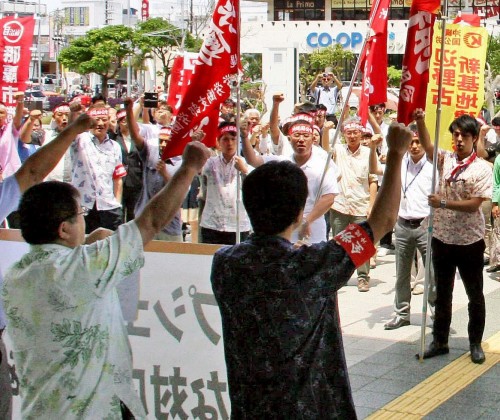
April 24, 2015 Ryukyu Shimpo
On April 23, 4 labor unions held an emergency session in front of the Okinawa General Bureau of the Japanese Government Cabinet Office in Naha. It included a public service union whose members work for the department which is carrying out the surveillance of protesters at Henoko. The same department is also demanding the removal of protesters’ tents from near the gate of Camp Schwab. The labor unions adopted a resolution to immediately stop the 24-hour surveillance and other excessive measures that could cause conflict between citizens and public service employees. In a questionnaire survey of workers involved in the surveillance, 80 percent thought it was excessive.
The Development and Construction Department of the Okinawa General Bureau has ordered its officials to carry out 24-hour surveillance of the protesters. The officials monitor the protest in front of the Camp Schwab gate in three shifts. They regularly visit the protest site between 9 p.m. and 9 a.m. Company workers began monitoring the protesters between 7 p.m. and 6 a.m. from the beginning of April.
The emergency session was organized by four public service employees unions, including ones representing workers in the Okinawa General Bureau. This is the first time that these four unions have worked together to appeal to the Japanese government. About 120 union members took part.
The resolution stated that the surveillance activities had forced workers into conflict with citizens, which had stressed them out both physically and mentally, and many workers had ended up becoming depressed. It demanded that the Japanese government stop making public service employees engage in any work related to the Henoko relocation.
Representing one of the unions, Sakae Umezawa said, “The surveillance of citizens who are protesting justifiably, is not a public service employee’s job.” A representative of another union Koji Shiraishi said, “I think the workers who are in charge of the surveillance, feel torn. It is unreasonable to ask them to do this.”
After the session, Shoho Kawai, the head of the Okinawa General Bureau talked to a Ryukyu Shimpo reporter. Kawai claimed, “The surveillance of protesting citizens is not excessive. The workers are doing what is needed.” He added, “I think that we are dealing properly with the situation while taking care of our employees’ work environment and their health.”
(English translation by T&CT)
Go to Japanese
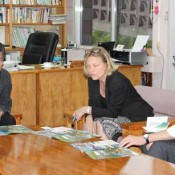
April 11, 2015 Ryukyu Shimpo
Diplomats from the embassies of four Nordic countries met with Mayor Susumu Inamine on April 10 to receive a briefing on the political situation, including the relocation of U.S. Marine Corps Air Station Futenma to Henoko in Nago. They heard about the mayor’s policy and how the Henoko issue is affecting the community.
The four diplomats are counsellors and first secretaries at the embassies of Sweden, Denmark, Finland and Norway.
Anna Hammarlund, first secretary at the Embassy of Sweden, said, “I could better understand about the situation of Okinawa by hearing about it from key persons.”
Mayor Inamine asked the diplomats to visit Henoko so they could convey the current situation in Okinawa to the wider world.
At the Okinawa Prefecutural Government Office, deputy governor Isho Urasaki explained to them that Governor Takeshi Onaga won the gubernatorial race last year on a platform of opposition to the construction of the new U.S. base at Henoko. He added that Henoko was the focal issue in the election. He said, “Governor Onaga is making every effort to move the Futenma base outside Okinawa by using all means available.”
(English translation by T&CT)
Go to Japanese
April 28, 2015 Ryukyu Shimpo
Prime Minister Shinzo Abe is slated to meet President Barack Obama today, April 28, in Washington DC. They are expected to discuss the new U.S. base in Henoko, Nago. We see action on that project being pushed forward in Okinawa by the Japanese and U.S. governments as a huge injustice and a negation of democracy.
What messages should those two governments be giving to the international community? Needless to say, we want them to convey commitment to universal values such as peace, freedom, human rights and democracy. By ignoring such values, they are driving forward their construction policy in Okinawa in an authoritarian and barbaric manner. If Japan and the U.S. are democratic states, they should respect the will of the people. We want the two leaders to drop the scheme for construction of a new U.S. base in Henoko and fulfill their responsibilities to justice.
U.S. Marines transferred to Okinawa from mainland Japan
They must bear at the forefront of their minds the following truths. Okinawan people have never themselves offered any land for U.S. bases, including U.S. Marine Corps Air Station Futenma. The U.S. military took the lands over for their own use – from the local people – during and immediately after the Battle of Okinawa in World War II and in the 1950s. The U.S. military deprived the residents, against their will, of all that extensive land by use of violent means. That action violated Article 46 of the Hague Conventions, an international agreement forbidding the confiscation of private property by any occupying powers.
We live in the 21st century, but the United States continues to use Okinawa in violation of international law, despite the elapse of 70 years since the end of that war. The local people have sought the closure Futenma and to achieve the return of the land, arguing that it poses a danger to themselves. But if Okinawa does not accept a new base elsewhere in the prefecture, Tokyo and Washington state they will not restore the base to the landowners. It is nothing other than a scandalous injustice.
In the days of the mainland Japan, anti-U.S. military base movement in the 1950s, U.S. forces, including the U.S. Marines, moved down to Okinawa. During the U.S. occupation of their islands, Okinawans were not allowed to express their opposition to military policy. Indeed, the U.S. Marines had not been stationed in Okinawa prior to that. Their presence on the island, moreover, led to the trampling underfoot of the rights of Okinawa.
It is not only Washington but also Tokyo that has treated Okinawa unfairly. The Japanese government has stressed that the Henoko relocation is the only way to remove the dangers posed by the Futenma base. However, the 1st Marine Aircraft Wing, based at Futenma, was moved in 1976 from Yamaguchi Prefecture, which happens to be Abe’s birthplace, that is, four years after the reversion of Okinawa to Japanese sovereignty. The Japanese government found no problem in relocating a U.S. military base from the mainland to Okinawa. However, they claim it is impossible to achieve the reverse.
Tokyo declares that the Okinawan Prefectural Government (OPG) agreed to the Henoko relocation 16 years ago. However, that agreement stipulated the OPG would permit the base to function for a limited period of 15 years. Okinawa has never agreed to host a long-term military base at Henoko.
President Obama should support the application of democracy to Okinawa. Since the plan to move the base to Henoko was proposed, the vast majority of people have opposed the plan, duly reflecting their views in opinion polls carried out in Okinawa. Not only has the mayor of Nago, to which the Henoko district belongs, but also the City Assembly, the Governor of Okinawa, and the Okinawa Prefectural Assembly have all rejected the Henoko relocation. If the same thing were to happen in a U.S. state, Washington would not be able to proceed with the construction of any new military base.
Embody universal values
Okinawa has endured suffering – continuously – for 70 years since the Battle of Okinawa: the lost right of self-determination, sexual violence and suppression of human rights and noise and environmental pollution, all have been prevalent in the prefecture.
There have been 45 cases of U.S. military aircraft crashing over the 43 years since the return of Okinawa to Japan. If the number of accidents involving aircraft parts falling from the sky and landing failures are added, the total number of incidents amounts to 594. If the U.S. and Japanese governments insist on continuing to station the Marine Corps unit in Okinawa and on moving the air base within the prefecture, the situation afflicting Okinawa will continue exactly as before. Everyone is well aware that that will not solve the problems arising from the presence of the U.S. military bases.
This is the time to reinstate justice for the Okinawan people. The Henoko relocation protest movement is nonviolent action similar to Mahatma Gandhi’s methods of nonviolent resistance. An 18-year-long resistance is comparable to the imprisonment and endurance of Nelson Mandela, the late President of South Africa. Okinawa is more entitled to claim and proclaim that it embodies respect for human rights, freedom and democracy than the U.S. and Japanese governments. The two leaders must face at that fact squarely.
Although Washington claims that it stations its military in Okinawa to protect Japan, it never does or would think of allowing itself to be involved in wars for the sake of Japan. It is impossible that the United States will engage in warfare with China because of several uninhabited outcrops in East China Sea, namely the Senkaku/Diaoyutai Islands. Washington stations the Marine Corps overseas primarily to protect its citizens abroad.
The U.S. military uses and expends arms, ammunition and materiel overseas, much to the benefit of the U.S. military-industrial complex. That is the real reason for stationing the U.S. military in other countries and regions, including Okinawa. We would like to ask the two leaders whether they can tolerate such a vast
injustice for the sake of those long-established vested interests.
(English translation by T&CT)
Go to Japanese
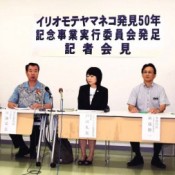
April 16, 2015 Ryukyu Shimpo
Taketomi Municipal Office will hold events to mark the 50th anniversary of the discovery of the Iriomote cat. The animal is a subspecies of the leopard and is only found on Iriomote Island, which is the largest of the Yaeyama Islands and the second largest island in Okinawa Prefecture. The cats have been designated a protected species by the national government.
On April 15, the municipal office set up an executive committee for the 50th anniversary to help the cats coexist with residents. The committee plans to hold events, including symposiums and concerts, to highlight the need to preserve the natural environment and to protect the endangered animal’s habitat.
Taketomo Mayor Eicho Kawamitsu, the chairperson of the committee, said, “Iriomote cats are our treasure, and we need to protect them for the future. We want to let people inside and outside the island know that this community will develop by living together with the wild cat.”
Taketomi Town plans to publish a joint declaration with Tsushima City, Nagasaki, which is home to another breed of wildcats. The declaration will be published in October and will call for the protection of all wildcats.
Also, an Iriomote cat drawing contest will be held for elementary and junior high school students in Taketomi.
The executive committee consists of Taketomi Municipal Office, the Ministry of the Environment’s Naha Natural Environmental Office, NPO Japan Tiger and Elephant Fund, Taketomi Town Tourist Association, Japan Transocean Air, and the Ryukyu Shimpo.
(English translation by T&CT, Hitomi Shinzato)
Go to Japanese
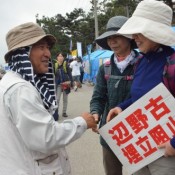
April 21, 2015 Ryukyu Shimpo
The Director of the Okinawa Peace Movement Center Hiroji Yamashiro has decided to retire from the sit-in protest at U.S. Marine Camp Schwab in Henoko, Nago, because of illness. On April 21, many ordinary citizens, including canoeists who protest in the sea off Henoko, gathered at the sit-in to encourage him.
Yamashiro told them that he had to focus on the struggle against his illness. “You make me try harder. I am striving to win victory,” he said.
Hiroshi Ashitomi, co-representative of the Helicopter Base Objection Association, said, “Yamashiro will come back here, the site of our struggle. I think he will overcome his disease with his strong will.”
The governments of Japan and the United States are carrying out preparation work on the seabed at Henoko for the building of a new air base, which is planned to replace the U.S. Marine Corps Air Station at Futenma. According to the protesters, drilling work took place at three locations that day.
(English translation by T&CT)
Go to Japanese
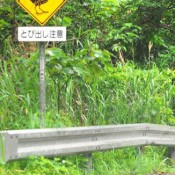
April 15, 2015 Ryukyu Shimpo
The Office of the Yanbaru Nature Ranger, part of the Environment Ministry, announced on April 13 that two Okinawa rails were killed on the roads in Kunigami in March.
Traffic accidents involving the birds reach their peak around May to June, during the breeding season. The Office of the Nature Ranger warned, “Accidents involving Okinawa rails tend to increase during this period as the birds frequently cross roads. The most important prevention measure we can take is to drive slowly. Please be very cautious when you drive around the Yanbaru area.”
The two Okinawa rails killed in March were both adult male birds. The first was found along Prefectural Road 70 in Ada, Kunigami Village at around 7:30 a.m. on March 2. The second bird was found along the forest road in Uka, at around 2 p.m. on March 22.
The Office of the Nature Ranger has asked people to report any instances of rails being injured or killed in traffic accidents. Similarly, anyone who finds an injured bird is asked to contact the Ranger.
For further details, call the Yanbaru Wildlife Conservation Center at 0980 (50) 1025 or NPO Hospital for Animals Okinawa 090 (6857) 8917.
(English translation by T&CT and Sayaka Sakuma)
Go to Japanese
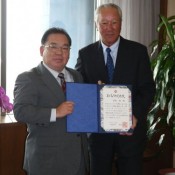
April 20, 2015 Ryukyu Shimpo
Isao Aoki who is one of Japan’s most successful golfers, has become a goodwill ambassador for Okinawa. Chiba Prefecture resident Aoki promised to convey the charm of Okinawa to the rest of the world. Vice Governor Mitsuo Agena gave Aoki a certificate to mark his appointment as ambassador at the Okinawa Prefectural Government office on April 20.
Aoki said, “Thanks to those who have been supporting me, I could become the goodwill ambassador for Okinawa.” After receiving the certificate, he told the press that he wanted to increase the number of golfers and fans.
As well as volunteering at a junior golfers’ development event in 2012, Aoki trained students at Okinawa junior golf school in 2013. He has also been promoting Okinawan golf by taking part in competitions held in the prefecture and by training here.
(English translation by T&CT)
Go to Japanese
April 20, 2015 Kazuya Arakaki of Ryukyu Shimpo
On April 19, Okinawa Governor Takeshi Onaga who is visiting Taiwan, had a dinner meeting with executives of an economic organization comprising major Taiwanese companies at a hotel in Taipei. They talked for about two hours about promoting economic relations between Okinawa and Taiwan. Onaga said, “I hope that friendly relations between Taiwan and Okinawa can contribute to the development of Asian countries and Japan.”
The executives who attended the meeting belong to a major Taiwanese economic organization which has a membership of a hundred companies, including listed companies. Apart from the beginning, the dinner meeting was closed to the public. The Taiwanese side suggested promoting cooperation between Okinawan companies and Taiwan. They have also asked the Okinawa governor to work on a project whereby baseball teams based in Okinawa can take part in the Taiwanese professional baseball league.
The chairman of the organization Chiang Pin-kung, who is also a senior adviser of CTBC Bank, stressed the importance of the role played by Taiwan in connecting Japan, China and Southeast Asia. Chiang said, “I am confident that economic relations between Okinawa and Taiwan will develop further. With the visit of Okinawa Governor Onaga to Taiwan, we would like to strengthen our efforts to promote investment in both countries.”
Onaga said, “The dynamic economic growth in Asian countries has had an impact on Okinawa, which could become a bridge between Japan and other Asian countries. I hope the friendly relations between Taiwan and Okinawa will contribute to the development of other Asian countries and Japan.”
(English translation by T&CT)
Go to Japanese
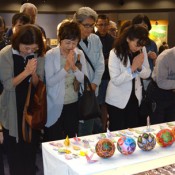
April 12, 2015 Ryukyu Shimpo
On April 11 at the Okinawa Prefectural Peace Memorial Museum in Itoman City, “the 8th Cornerstone of Peace Memorial Shimi Festival” was held to commemorate the war dead and honor the ancestors. Shimi ritual dishes and fruits were offered at the Okinawa Peace Memorial Monument. Ryukyuan thread balls and origami paper cranes were also laid at the memorial as about 400 people gathered to pray for lasting peace.
A graduate student from Holland Gijis van der Lubbe, who studies Ryukyuan languages at the University of Ryukyus, made an address in Shimakutuba. Lubbe said, “Mirukuyu nu unige to shite, kwaumaga hajimi, shike umanchunu cha, mimanti utabimi shebiri (As a prayer to the god of peace, please watch over our children, grandchildren, and all people of the world).”
Living national treasure Choichi Terukina played a classical Ryukyuan song “Nakafubushi.”The Okinawa Male Choir dedicated songs such as “Danju Kariyushi” to the monument.
Natsumi Hamamoto from Naha City, who attended the ceremony with her kids, said, “I pray for a peaceful world and that war will not occur when my kids grow up.”
(English translation by T&CT and Megumi Chibana)
Go to Japanese
April 15, 2015 Ryukyu Shimpo
On April 14, Okinawa Governor Takeshi Onaga visited China as one of the delegates of the Association for the Promotion of International Trade Japan. Onaga met the Premier of the State Council of the People’s Republic of China, Li Keqiang, at the Great Hall of the People in Beijing. Referring to the historical links between Okinawa and China, Onaga asked for the promotion of trade in the special economic zones in Fujian and Okinawa and for the opening of a new airline route between Naha and Fuzhou. Premier Li said, “We would like to promote exchanges with all regions of Japan, including Okinawa.”
This is the first time that Li has met a Japanese governor since he took office. Li and the delegates met for about an hour. Apart from the delegate leader Yohei Kono, Onaga is the only delegate who talked to Li for as long as 10 minutes.
Onaga talked about the Ryukyuan cemetery in Fujian and the history of students from the Ryukyu Kingdom studying in Beijing. He said, “These people supported the nerve center of the Ryukyu Kingdom, which made the Ryukyu a ‘Bridge between Asian nations.'”
Referring to the Fujian Free Trade Zone, Onaga said, “Okinawa is unique in Japan, having its own free-trade zone. I would like to promote economic exchanges between Okinawa and China.” He continued, “I hope that airlines will start flying between Naha and Fuzhou.”
Li said, “It is important for us to learn about our history with Okinawa. The Chinese government is actively promoting exchanges with all regions of Japan.”
In the meeting between the Chinese Premier and the delegate members, Li and Kono exchanged opinions on Japan and China’s economic relations, and on historical issues. Li said, “I think both China and Japan have the will to improve this difficult situation.”
This is the first time that Li and Japanese political figures have held a meeting. In addition to marking a gradual improvement in relations between Japan and China, the Chinese side attached importance to the political stance of Kono who has strong concerns over the Japanese administration led by Prime Minister Shinzo Abe.
(English translation by T&CT)
Go to Japanese
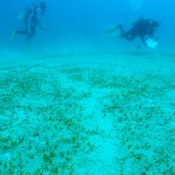
April 16, 2015 Ryukyu Shimpo
Dugong bite marks were found on April 15 at a depth of 19.7 meters under water in a part of Oura Bay adjacent to the planned Henoko base. Dugong bite marks have never been found at such a depth in Japan before. There is a possibility that the seabed-boring survey off Henoko has driven the animals into deeper waters.
The Dugong Network Okinawa, Northern Limit Dugong Research Team Zan, and Diving Team Rainbow of the Helicopter Base Objection Association found the marks outside the temporary restricted area. The divers confirmed 35 bite marks in an area of the sea-bed, 50 meters in diameter. They say the latest marks were made about a week ago. The length of the marks are relatively short, at between 1.9 and 10.5 meters. The marks seem to have been made by the youngest of the three dugongs that the Okinawa Defense Bureau claim inhabit the waters around the main island of Okinawa.
Morihide Tanahara, a representative of the Dugong Network Okinawa said, “I think the boring survey forced the marine mammals to move to a deeper part of the sea to eat. The dugong pushed itself to be in such deep-water.” Mariko Abe of the Nature Conservation Society of Japan said, “It is rare that dugongs eat at a depth of 19.7 meters under water.” Abe added, “There is a high possibility that the boring survey could have driven the marine mammals out of the shallow waters, where bite marks of dugongs have previously been observed.”
There have been concerns that the boring survey could drive dugongs away from their feeding sites. Although the society requested the U.S. military in Japan carry out a survey on dugong feeding habits within the restricted area, the request was rejected. A survey carried out by the defense bureau confirmed the existence of dugongs on September 1 2014. Since then, the bureau has not made any announcements confirming the existence of dugongs.
(English translation by T&CT)
Go to Japanese








 Webcam(Kokusai Street)
Webcam(Kokusai Street)


